CER078 Report: Diabetes - Physiological Effects, Diagnosis, and Care
VerifiedAdded on 2022/12/27
|22
|4527
|3
Report
AI Summary
This report provides a comprehensive overview of diabetes, addressing its physiological effects on various organ systems such as blood vessels, wounds, feet, kidneys, vision, skin, the digestive system, and fertility. It differentiates between Type 1, Type 2, and gestational diabetes, outlining their key physiological origins and contributory factors including family history, obesity, age, and ethnic background. The report details the investigative processes involved in diagnosing diabetes, including fasting plasma glucose tests, oral glucose tolerance tests, random plasma glucose tests, and A1C tests. It also presents a flow chart of the referral process for newly diagnosed diabetes cases. Furthermore, the report summarizes the available treatment and monitoring processes, including insulin therapy, metformin, SGLT2 inhibitors, GLP-1 receptor agonists, and the importance of exercise and diet. The roles and responsibilities of healthcare specialists such as GPs, nurses, clinical specialists, and care assistants are explained. The report also compares different care settings (hospital, home, and clinic), analyzing their services, positive and negative aspects for patients. Finally, it includes an analysis of the settings and the care services available.

Running Head: BLOOD-SUGAR
0
Diabetes
student
6/13/2019
0
Diabetes
student
6/13/2019
Paraphrase This Document
Need a fresh take? Get an instant paraphrase of this document with our AI Paraphraser
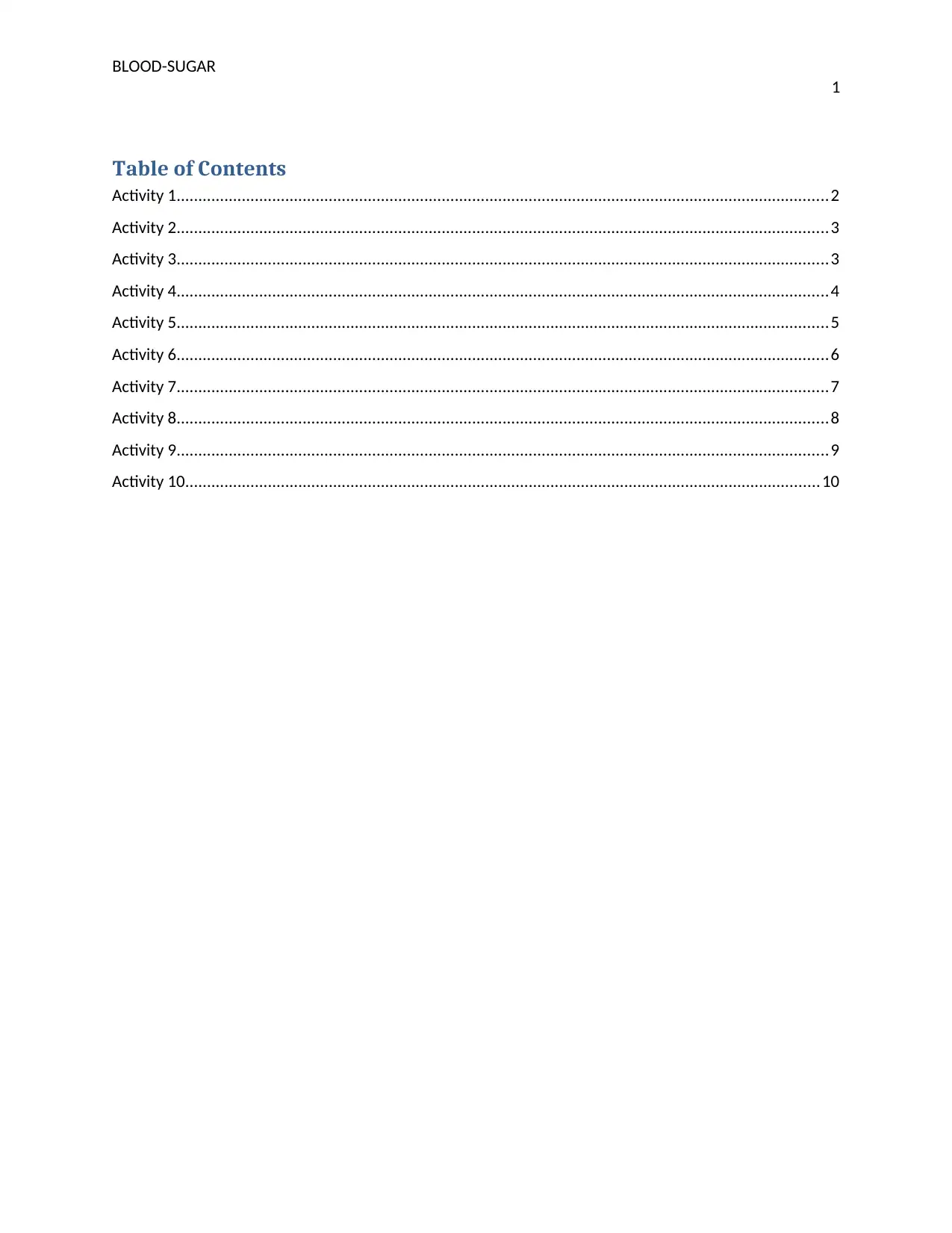
BLOOD-SUGAR
1
Table of Contents
Activity 1......................................................................................................................................................2
Activity 2......................................................................................................................................................3
Activity 3......................................................................................................................................................3
Activity 4......................................................................................................................................................4
Activity 5......................................................................................................................................................5
Activity 6......................................................................................................................................................6
Activity 7......................................................................................................................................................7
Activity 8......................................................................................................................................................8
Activity 9......................................................................................................................................................9
Activity 10..................................................................................................................................................10
1
Table of Contents
Activity 1......................................................................................................................................................2
Activity 2......................................................................................................................................................3
Activity 3......................................................................................................................................................3
Activity 4......................................................................................................................................................4
Activity 5......................................................................................................................................................5
Activity 6......................................................................................................................................................6
Activity 7......................................................................................................................................................7
Activity 8......................................................................................................................................................8
Activity 9......................................................................................................................................................9
Activity 10..................................................................................................................................................10
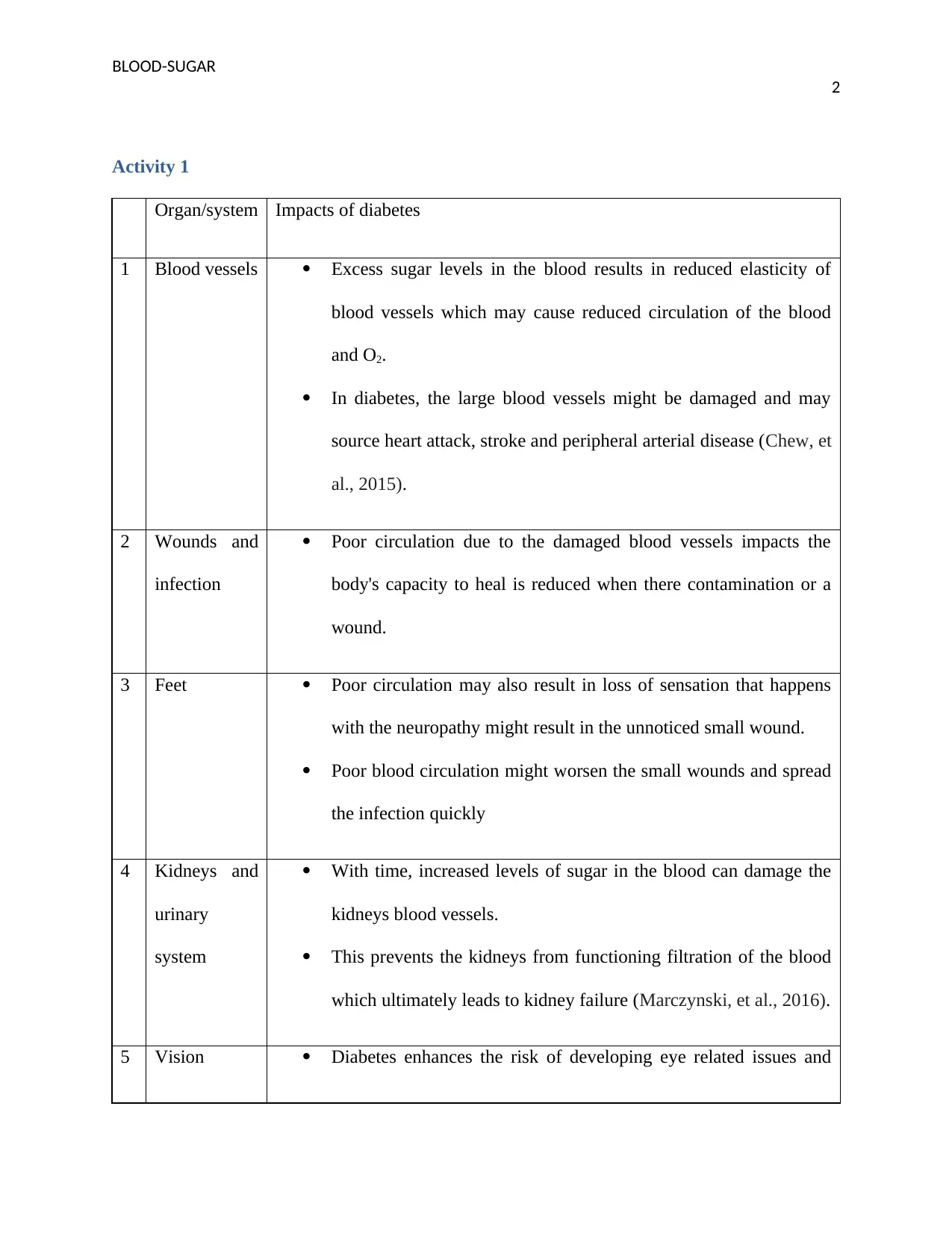
BLOOD-SUGAR
2
Activity 1
Organ/system Impacts of diabetes
1 Blood vessels Excess sugar levels in the blood results in reduced elasticity of
blood vessels which may cause reduced circulation of the blood
and O2.
In diabetes, the large blood vessels might be damaged and may
source heart attack, stroke and peripheral arterial disease (Chew, et
al., 2015).
2 Wounds and
infection
Poor circulation due to the damaged blood vessels impacts the
body's capacity to heal is reduced when there contamination or a
wound.
3 Feet Poor circulation may also result in loss of sensation that happens
with the neuropathy might result in the unnoticed small wound.
Poor blood circulation might worsen the small wounds and spread
the infection quickly
4 Kidneys and
urinary
system
With time, increased levels of sugar in the blood can damage the
kidneys blood vessels.
This prevents the kidneys from functioning filtration of the blood
which ultimately leads to kidney failure (Marczynski, et al., 2016).
5 Vision Diabetes enhances the risk of developing eye related issues and
2
Activity 1
Organ/system Impacts of diabetes
1 Blood vessels Excess sugar levels in the blood results in reduced elasticity of
blood vessels which may cause reduced circulation of the blood
and O2.
In diabetes, the large blood vessels might be damaged and may
source heart attack, stroke and peripheral arterial disease (Chew, et
al., 2015).
2 Wounds and
infection
Poor circulation due to the damaged blood vessels impacts the
body's capacity to heal is reduced when there contamination or a
wound.
3 Feet Poor circulation may also result in loss of sensation that happens
with the neuropathy might result in the unnoticed small wound.
Poor blood circulation might worsen the small wounds and spread
the infection quickly
4 Kidneys and
urinary
system
With time, increased levels of sugar in the blood can damage the
kidneys blood vessels.
This prevents the kidneys from functioning filtration of the blood
which ultimately leads to kidney failure (Marczynski, et al., 2016).
5 Vision Diabetes enhances the risk of developing eye related issues and
⊘ This is a preview!⊘
Do you want full access?
Subscribe today to unlock all pages.

Trusted by 1+ million students worldwide
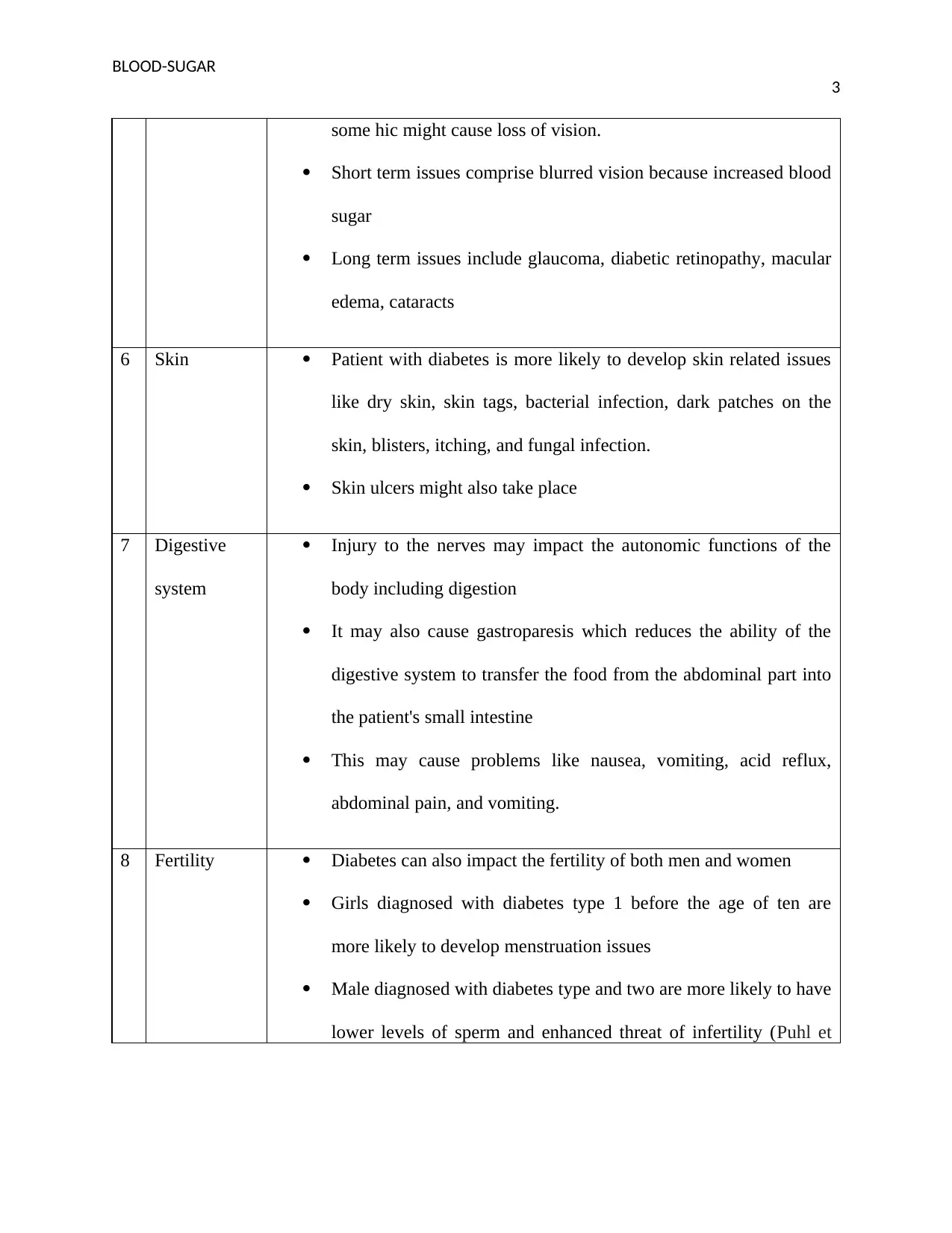
BLOOD-SUGAR
3
some hic might cause loss of vision.
Short term issues comprise blurred vision because increased blood
sugar
Long term issues include glaucoma, diabetic retinopathy, macular
edema, cataracts
6 Skin Patient with diabetes is more likely to develop skin related issues
like dry skin, skin tags, bacterial infection, dark patches on the
skin, blisters, itching, and fungal infection.
Skin ulcers might also take place
7 Digestive
system
Injury to the nerves may impact the autonomic functions of the
body including digestion
It may also cause gastroparesis which reduces the ability of the
digestive system to transfer the food from the abdominal part into
the patient's small intestine
This may cause problems like nausea, vomiting, acid reflux,
abdominal pain, and vomiting.
8 Fertility Diabetes can also impact the fertility of both men and women
Girls diagnosed with diabetes type 1 before the age of ten are
more likely to develop menstruation issues
Male diagnosed with diabetes type and two are more likely to have
lower levels of sperm and enhanced threat of infertility (Puhl et
3
some hic might cause loss of vision.
Short term issues comprise blurred vision because increased blood
sugar
Long term issues include glaucoma, diabetic retinopathy, macular
edema, cataracts
6 Skin Patient with diabetes is more likely to develop skin related issues
like dry skin, skin tags, bacterial infection, dark patches on the
skin, blisters, itching, and fungal infection.
Skin ulcers might also take place
7 Digestive
system
Injury to the nerves may impact the autonomic functions of the
body including digestion
It may also cause gastroparesis which reduces the ability of the
digestive system to transfer the food from the abdominal part into
the patient's small intestine
This may cause problems like nausea, vomiting, acid reflux,
abdominal pain, and vomiting.
8 Fertility Diabetes can also impact the fertility of both men and women
Girls diagnosed with diabetes type 1 before the age of ten are
more likely to develop menstruation issues
Male diagnosed with diabetes type and two are more likely to have
lower levels of sperm and enhanced threat of infertility (Puhl et
Paraphrase This Document
Need a fresh take? Get an instant paraphrase of this document with our AI Paraphraser
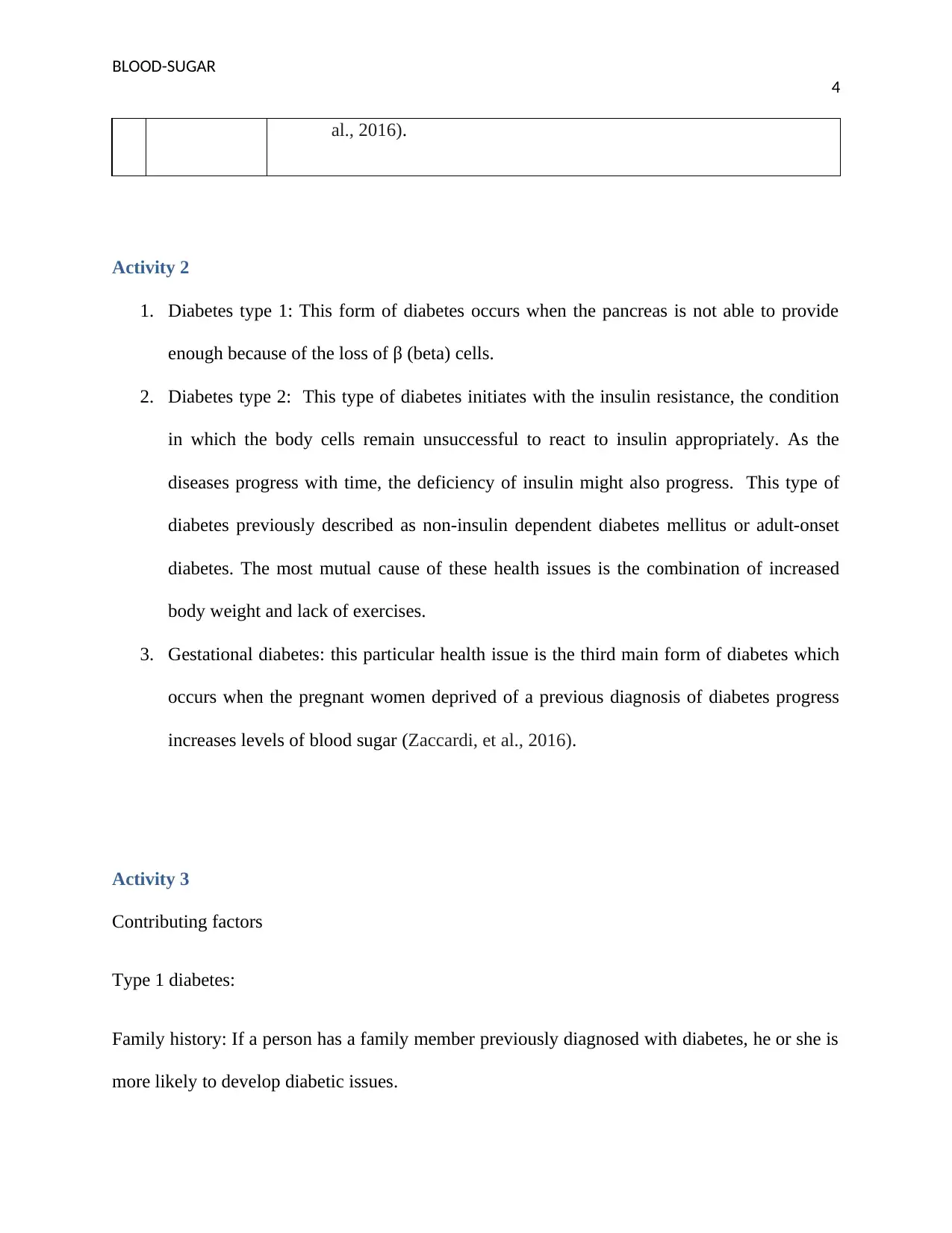
BLOOD-SUGAR
4
al., 2016).
Activity 2
1. Diabetes type 1: This form of diabetes occurs when the pancreas is not able to provide
enough because of the loss of β (beta) cells.
2. Diabetes type 2: This type of diabetes initiates with the insulin resistance, the condition
in which the body cells remain unsuccessful to react to insulin appropriately. As the
diseases progress with time, the deficiency of insulin might also progress. This type of
diabetes previously described as non-insulin dependent diabetes mellitus or adult-onset
diabetes. The most mutual cause of these health issues is the combination of increased
body weight and lack of exercises.
3. Gestational diabetes: this particular health issue is the third main form of diabetes which
occurs when the pregnant women deprived of a previous diagnosis of diabetes progress
increases levels of blood sugar (Zaccardi, et al., 2016).
Activity 3
Contributing factors
Type 1 diabetes:
Family history: If a person has a family member previously diagnosed with diabetes, he or she is
more likely to develop diabetic issues.
4
al., 2016).
Activity 2
1. Diabetes type 1: This form of diabetes occurs when the pancreas is not able to provide
enough because of the loss of β (beta) cells.
2. Diabetes type 2: This type of diabetes initiates with the insulin resistance, the condition
in which the body cells remain unsuccessful to react to insulin appropriately. As the
diseases progress with time, the deficiency of insulin might also progress. This type of
diabetes previously described as non-insulin dependent diabetes mellitus or adult-onset
diabetes. The most mutual cause of these health issues is the combination of increased
body weight and lack of exercises.
3. Gestational diabetes: this particular health issue is the third main form of diabetes which
occurs when the pregnant women deprived of a previous diagnosis of diabetes progress
increases levels of blood sugar (Zaccardi, et al., 2016).
Activity 3
Contributing factors
Type 1 diabetes:
Family history: If a person has a family member previously diagnosed with diabetes, he or she is
more likely to develop diabetic issues.
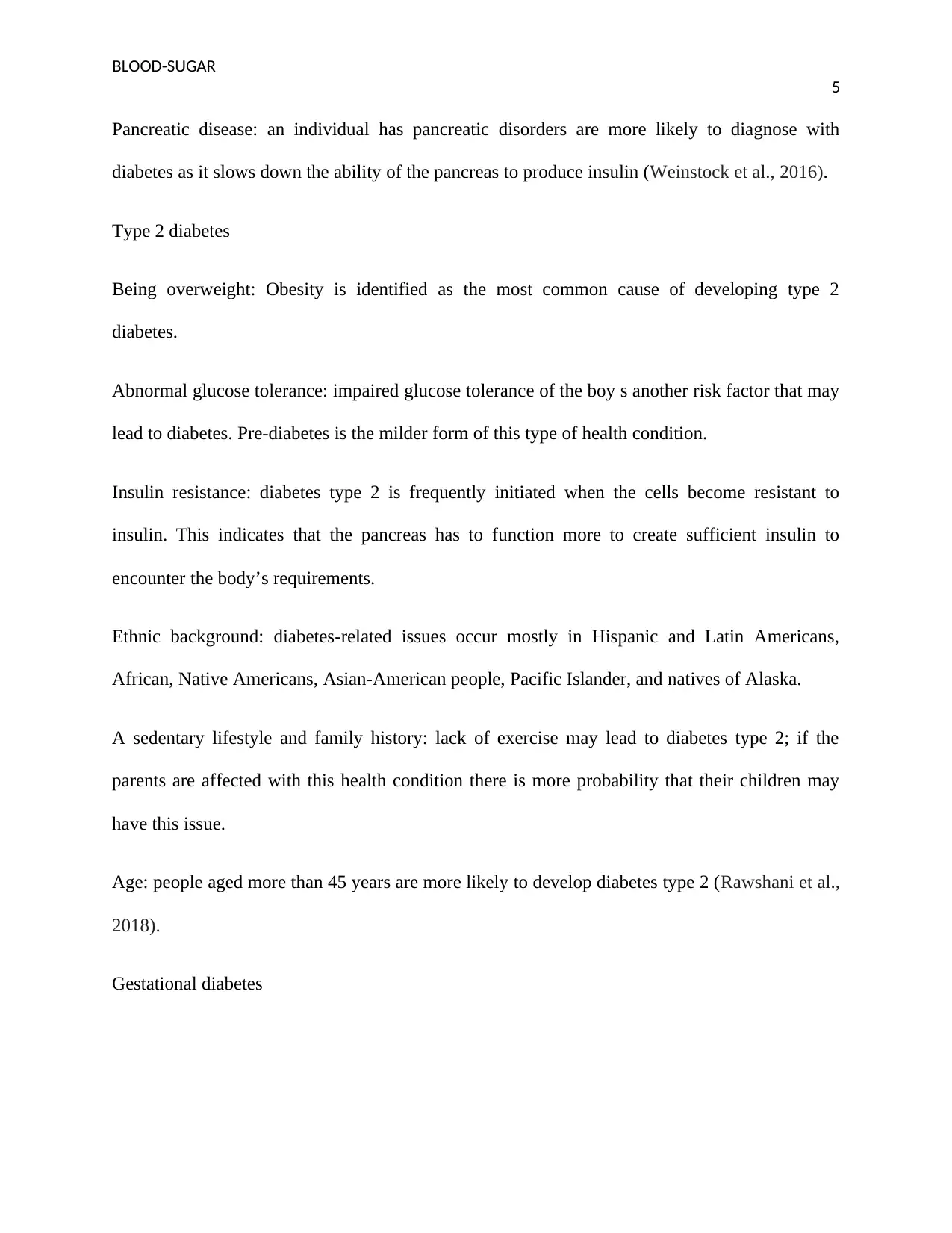
BLOOD-SUGAR
5
Pancreatic disease: an individual has pancreatic disorders are more likely to diagnose with
diabetes as it slows down the ability of the pancreas to produce insulin (Weinstock et al., 2016).
Type 2 diabetes
Being overweight: Obesity is identified as the most common cause of developing type 2
diabetes.
Abnormal glucose tolerance: impaired glucose tolerance of the boy s another risk factor that may
lead to diabetes. Pre-diabetes is the milder form of this type of health condition.
Insulin resistance: diabetes type 2 is frequently initiated when the cells become resistant to
insulin. This indicates that the pancreas has to function more to create sufficient insulin to
encounter the body’s requirements.
Ethnic background: diabetes-related issues occur mostly in Hispanic and Latin Americans,
African, Native Americans, Asian-American people, Pacific Islander, and natives of Alaska.
A sedentary lifestyle and family history: lack of exercise may lead to diabetes type 2; if the
parents are affected with this health condition there is more probability that their children may
have this issue.
Age: people aged more than 45 years are more likely to develop diabetes type 2 (Rawshani et al.,
2018).
Gestational diabetes
5
Pancreatic disease: an individual has pancreatic disorders are more likely to diagnose with
diabetes as it slows down the ability of the pancreas to produce insulin (Weinstock et al., 2016).
Type 2 diabetes
Being overweight: Obesity is identified as the most common cause of developing type 2
diabetes.
Abnormal glucose tolerance: impaired glucose tolerance of the boy s another risk factor that may
lead to diabetes. Pre-diabetes is the milder form of this type of health condition.
Insulin resistance: diabetes type 2 is frequently initiated when the cells become resistant to
insulin. This indicates that the pancreas has to function more to create sufficient insulin to
encounter the body’s requirements.
Ethnic background: diabetes-related issues occur mostly in Hispanic and Latin Americans,
African, Native Americans, Asian-American people, Pacific Islander, and natives of Alaska.
A sedentary lifestyle and family history: lack of exercise may lead to diabetes type 2; if the
parents are affected with this health condition there is more probability that their children may
have this issue.
Age: people aged more than 45 years are more likely to develop diabetes type 2 (Rawshani et al.,
2018).
Gestational diabetes
⊘ This is a preview!⊘
Do you want full access?
Subscribe today to unlock all pages.

Trusted by 1+ million students worldwide
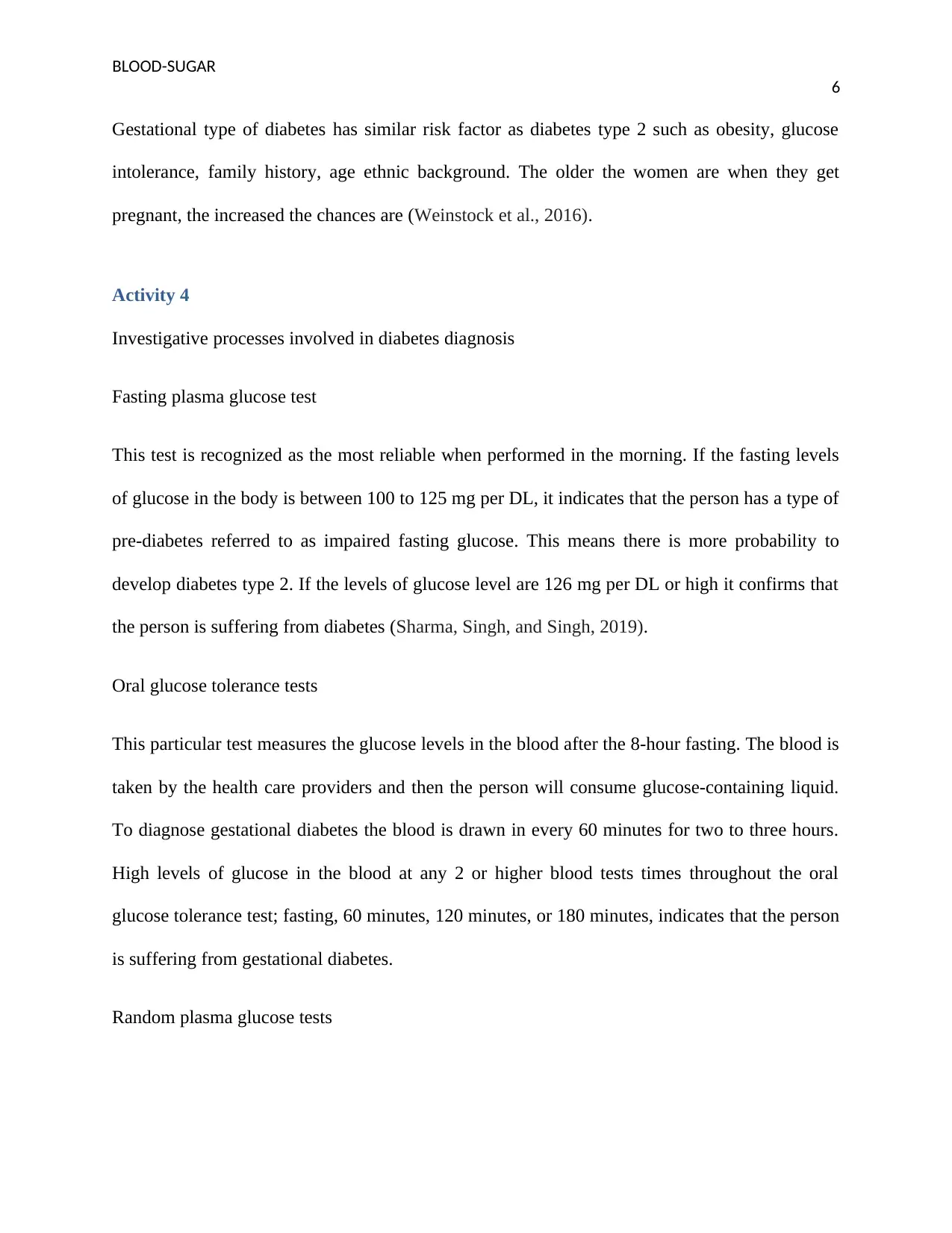
BLOOD-SUGAR
6
Gestational type of diabetes has similar risk factor as diabetes type 2 such as obesity, glucose
intolerance, family history, age ethnic background. The older the women are when they get
pregnant, the increased the chances are (Weinstock et al., 2016).
Activity 4
Investigative processes involved in diabetes diagnosis
Fasting plasma glucose test
This test is recognized as the most reliable when performed in the morning. If the fasting levels
of glucose in the body is between 100 to 125 mg per DL, it indicates that the person has a type of
pre-diabetes referred to as impaired fasting glucose. This means there is more probability to
develop diabetes type 2. If the levels of glucose level are 126 mg per DL or high it confirms that
the person is suffering from diabetes (Sharma, Singh, and Singh, 2019).
Oral glucose tolerance tests
This particular test measures the glucose levels in the blood after the 8-hour fasting. The blood is
taken by the health care providers and then the person will consume glucose-containing liquid.
To diagnose gestational diabetes the blood is drawn in every 60 minutes for two to three hours.
High levels of glucose in the blood at any 2 or higher blood tests times throughout the oral
glucose tolerance test; fasting, 60 minutes, 120 minutes, or 180 minutes, indicates that the person
is suffering from gestational diabetes.
Random plasma glucose tests
6
Gestational type of diabetes has similar risk factor as diabetes type 2 such as obesity, glucose
intolerance, family history, age ethnic background. The older the women are when they get
pregnant, the increased the chances are (Weinstock et al., 2016).
Activity 4
Investigative processes involved in diabetes diagnosis
Fasting plasma glucose test
This test is recognized as the most reliable when performed in the morning. If the fasting levels
of glucose in the body is between 100 to 125 mg per DL, it indicates that the person has a type of
pre-diabetes referred to as impaired fasting glucose. This means there is more probability to
develop diabetes type 2. If the levels of glucose level are 126 mg per DL or high it confirms that
the person is suffering from diabetes (Sharma, Singh, and Singh, 2019).
Oral glucose tolerance tests
This particular test measures the glucose levels in the blood after the 8-hour fasting. The blood is
taken by the health care providers and then the person will consume glucose-containing liquid.
To diagnose gestational diabetes the blood is drawn in every 60 minutes for two to three hours.
High levels of glucose in the blood at any 2 or higher blood tests times throughout the oral
glucose tolerance test; fasting, 60 minutes, 120 minutes, or 180 minutes, indicates that the person
is suffering from gestational diabetes.
Random plasma glucose tests
Paraphrase This Document
Need a fresh take? Get an instant paraphrase of this document with our AI Paraphraser
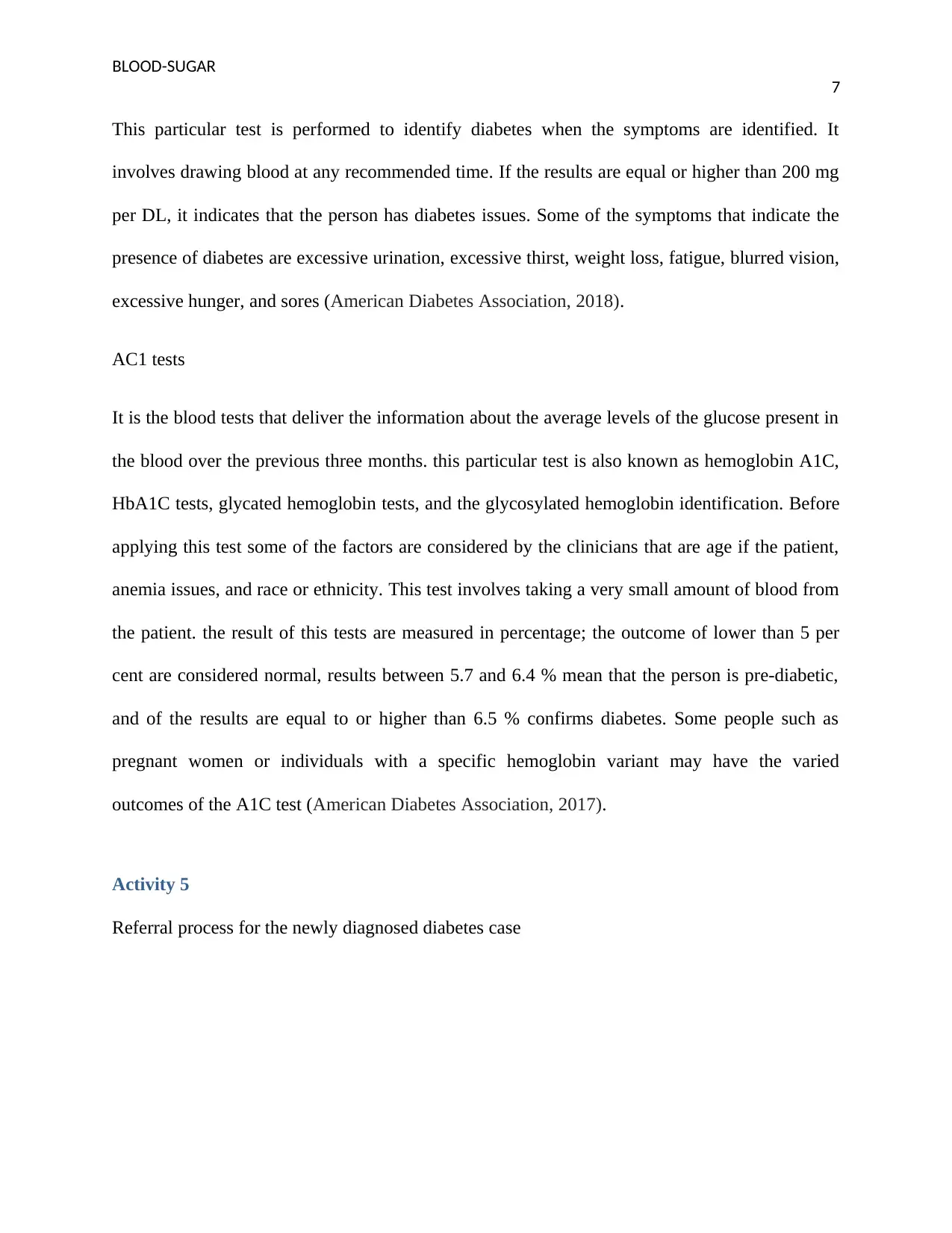
BLOOD-SUGAR
7
This particular test is performed to identify diabetes when the symptoms are identified. It
involves drawing blood at any recommended time. If the results are equal or higher than 200 mg
per DL, it indicates that the person has diabetes issues. Some of the symptoms that indicate the
presence of diabetes are excessive urination, excessive thirst, weight loss, fatigue, blurred vision,
excessive hunger, and sores (American Diabetes Association, 2018).
AC1 tests
It is the blood tests that deliver the information about the average levels of the glucose present in
the blood over the previous three months. this particular test is also known as hemoglobin A1C,
HbA1C tests, glycated hemoglobin tests, and the glycosylated hemoglobin identification. Before
applying this test some of the factors are considered by the clinicians that are age if the patient,
anemia issues, and race or ethnicity. This test involves taking a very small amount of blood from
the patient. the result of this tests are measured in percentage; the outcome of lower than 5 per
cent are considered normal, results between 5.7 and 6.4 % mean that the person is pre-diabetic,
and of the results are equal to or higher than 6.5 % confirms diabetes. Some people such as
pregnant women or individuals with a specific hemoglobin variant may have the varied
outcomes of the A1C test (American Diabetes Association, 2017).
Activity 5
Referral process for the newly diagnosed diabetes case
7
This particular test is performed to identify diabetes when the symptoms are identified. It
involves drawing blood at any recommended time. If the results are equal or higher than 200 mg
per DL, it indicates that the person has diabetes issues. Some of the symptoms that indicate the
presence of diabetes are excessive urination, excessive thirst, weight loss, fatigue, blurred vision,
excessive hunger, and sores (American Diabetes Association, 2018).
AC1 tests
It is the blood tests that deliver the information about the average levels of the glucose present in
the blood over the previous three months. this particular test is also known as hemoglobin A1C,
HbA1C tests, glycated hemoglobin tests, and the glycosylated hemoglobin identification. Before
applying this test some of the factors are considered by the clinicians that are age if the patient,
anemia issues, and race or ethnicity. This test involves taking a very small amount of blood from
the patient. the result of this tests are measured in percentage; the outcome of lower than 5 per
cent are considered normal, results between 5.7 and 6.4 % mean that the person is pre-diabetic,
and of the results are equal to or higher than 6.5 % confirms diabetes. Some people such as
pregnant women or individuals with a specific hemoglobin variant may have the varied
outcomes of the A1C test (American Diabetes Association, 2017).
Activity 5
Referral process for the newly diagnosed diabetes case
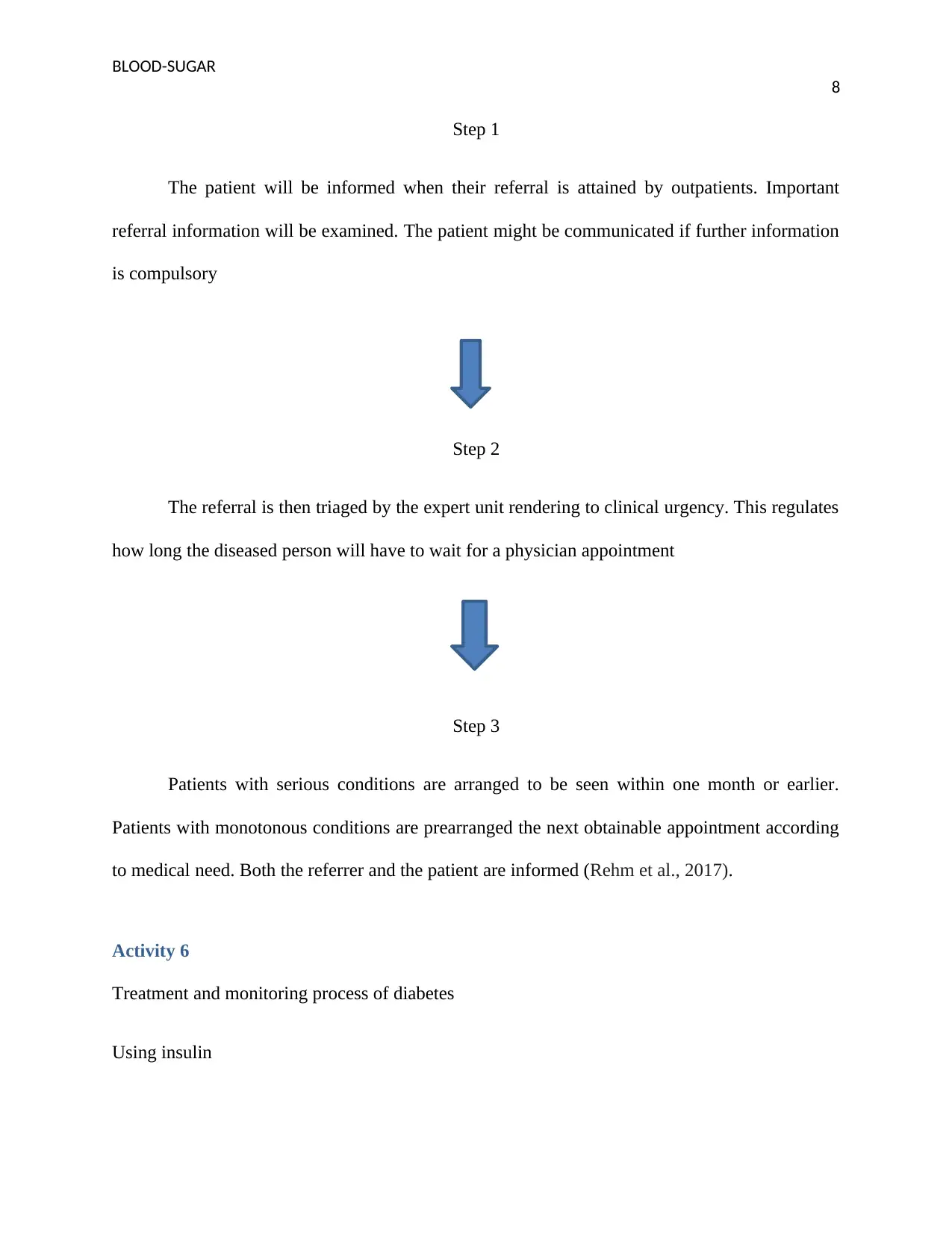
BLOOD-SUGAR
8
Step 1
The patient will be informed when their referral is attained by outpatients. Important
referral information will be examined. The patient might be communicated if further information
is compulsory
Step 2
The referral is then triaged by the expert unit rendering to clinical urgency. This regulates
how long the diseased person will have to wait for a physician appointment
Step 3
Patients with serious conditions are arranged to be seen within one month or earlier.
Patients with monotonous conditions are prearranged the next obtainable appointment according
to medical need. Both the referrer and the patient are informed (Rehm et al., 2017).
Activity 6
Treatment and monitoring process of diabetes
Using insulin
8
Step 1
The patient will be informed when their referral is attained by outpatients. Important
referral information will be examined. The patient might be communicated if further information
is compulsory
Step 2
The referral is then triaged by the expert unit rendering to clinical urgency. This regulates
how long the diseased person will have to wait for a physician appointment
Step 3
Patients with serious conditions are arranged to be seen within one month or earlier.
Patients with monotonous conditions are prearranged the next obtainable appointment according
to medical need. Both the referrer and the patient are informed (Rehm et al., 2017).
Activity 6
Treatment and monitoring process of diabetes
Using insulin
⊘ This is a preview!⊘
Do you want full access?
Subscribe today to unlock all pages.

Trusted by 1+ million students worldwide
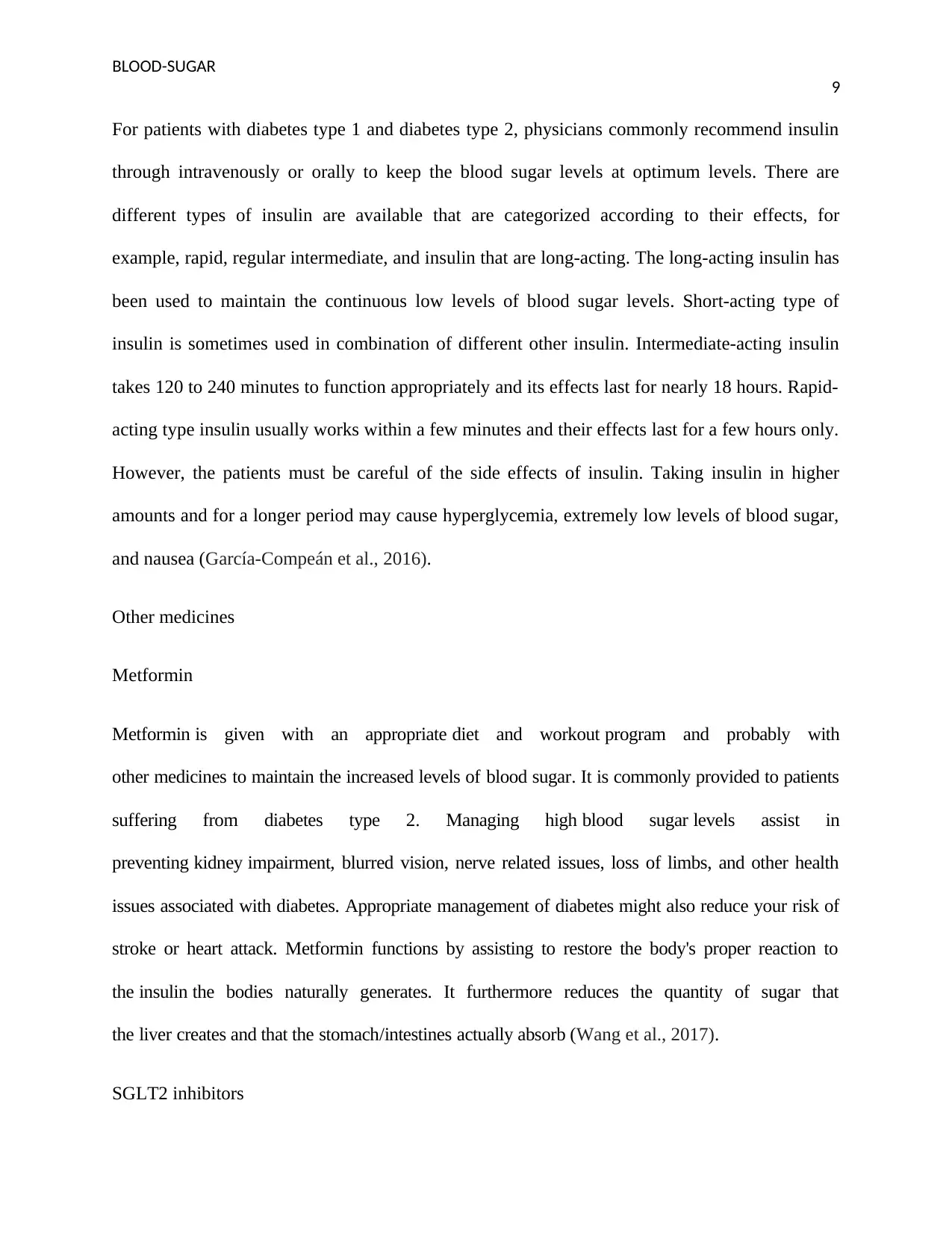
BLOOD-SUGAR
9
For patients with diabetes type 1 and diabetes type 2, physicians commonly recommend insulin
through intravenously or orally to keep the blood sugar levels at optimum levels. There are
different types of insulin are available that are categorized according to their effects, for
example, rapid, regular intermediate, and insulin that are long-acting. The long-acting insulin has
been used to maintain the continuous low levels of blood sugar levels. Short-acting type of
insulin is sometimes used in combination of different other insulin. Intermediate-acting insulin
takes 120 to 240 minutes to function appropriately and its effects last for nearly 18 hours. Rapid-
acting type insulin usually works within a few minutes and their effects last for a few hours only.
However, the patients must be careful of the side effects of insulin. Taking insulin in higher
amounts and for a longer period may cause hyperglycemia, extremely low levels of blood sugar,
and nausea (García-Compeán et al., 2016).
Other medicines
Metformin
Metformin is given with an appropriate diet and workout program and probably with
other medicines to maintain the increased levels of blood sugar. It is commonly provided to patients
suffering from diabetes type 2. Managing high blood sugar levels assist in
preventing kidney impairment, blurred vision, nerve related issues, loss of limbs, and other health
issues associated with diabetes. Appropriate management of diabetes might also reduce your risk of
stroke or heart attack. Metformin functions by assisting to restore the body's proper reaction to
the insulin the bodies naturally generates. It furthermore reduces the quantity of sugar that
the liver creates and that the stomach/intestines actually absorb (Wang et al., 2017).
SGLT2 inhibitors
9
For patients with diabetes type 1 and diabetes type 2, physicians commonly recommend insulin
through intravenously or orally to keep the blood sugar levels at optimum levels. There are
different types of insulin are available that are categorized according to their effects, for
example, rapid, regular intermediate, and insulin that are long-acting. The long-acting insulin has
been used to maintain the continuous low levels of blood sugar levels. Short-acting type of
insulin is sometimes used in combination of different other insulin. Intermediate-acting insulin
takes 120 to 240 minutes to function appropriately and its effects last for nearly 18 hours. Rapid-
acting type insulin usually works within a few minutes and their effects last for a few hours only.
However, the patients must be careful of the side effects of insulin. Taking insulin in higher
amounts and for a longer period may cause hyperglycemia, extremely low levels of blood sugar,
and nausea (García-Compeán et al., 2016).
Other medicines
Metformin
Metformin is given with an appropriate diet and workout program and probably with
other medicines to maintain the increased levels of blood sugar. It is commonly provided to patients
suffering from diabetes type 2. Managing high blood sugar levels assist in
preventing kidney impairment, blurred vision, nerve related issues, loss of limbs, and other health
issues associated with diabetes. Appropriate management of diabetes might also reduce your risk of
stroke or heart attack. Metformin functions by assisting to restore the body's proper reaction to
the insulin the bodies naturally generates. It furthermore reduces the quantity of sugar that
the liver creates and that the stomach/intestines actually absorb (Wang et al., 2017).
SGLT2 inhibitors
Paraphrase This Document
Need a fresh take? Get an instant paraphrase of this document with our AI Paraphraser
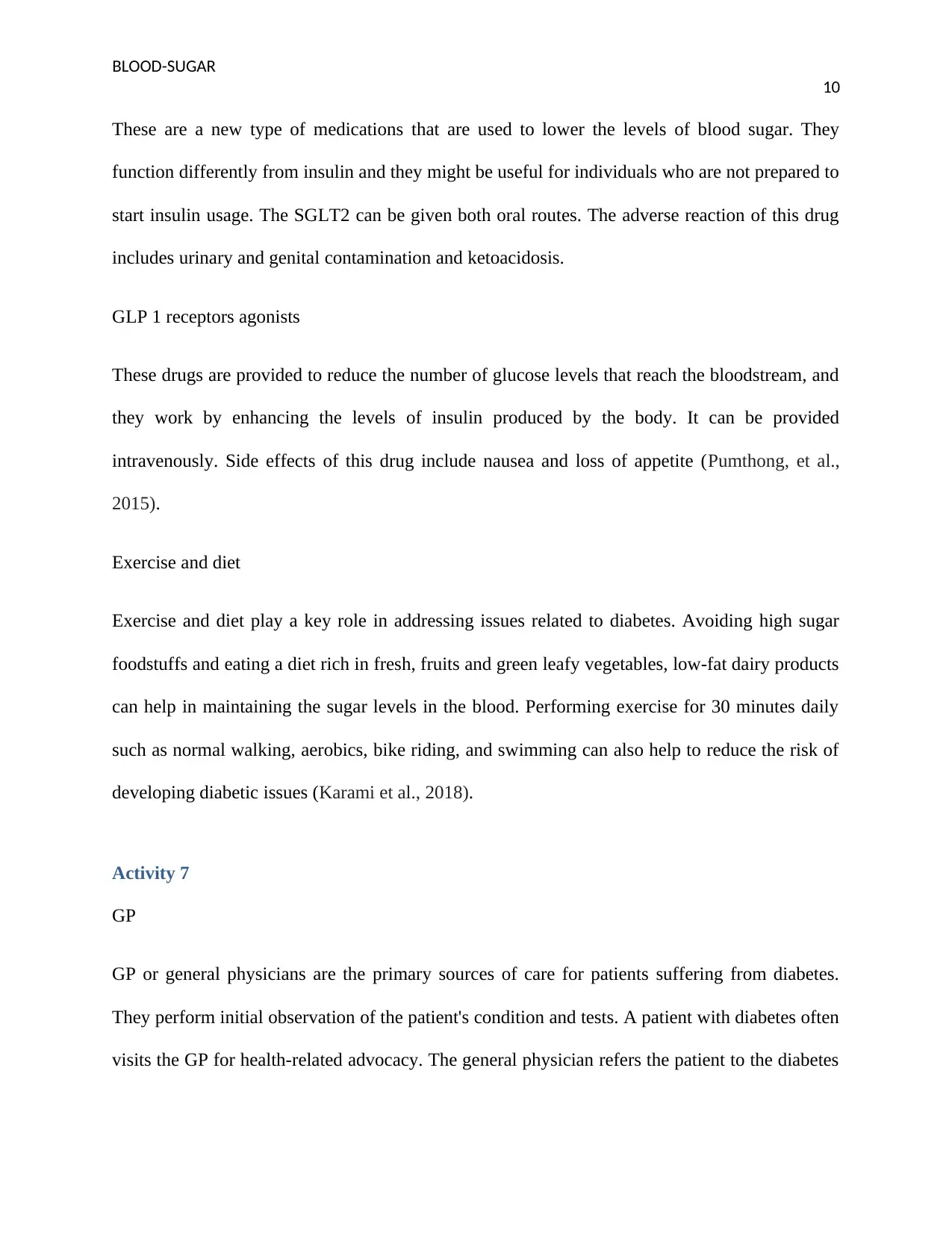
BLOOD-SUGAR
10
These are a new type of medications that are used to lower the levels of blood sugar. They
function differently from insulin and they might be useful for individuals who are not prepared to
start insulin usage. The SGLT2 can be given both oral routes. The adverse reaction of this drug
includes urinary and genital contamination and ketoacidosis.
GLP 1 receptors agonists
These drugs are provided to reduce the number of glucose levels that reach the bloodstream, and
they work by enhancing the levels of insulin produced by the body. It can be provided
intravenously. Side effects of this drug include nausea and loss of appetite (Pumthong, et al.,
2015).
Exercise and diet
Exercise and diet play a key role in addressing issues related to diabetes. Avoiding high sugar
foodstuffs and eating a diet rich in fresh, fruits and green leafy vegetables, low-fat dairy products
can help in maintaining the sugar levels in the blood. Performing exercise for 30 minutes daily
such as normal walking, aerobics, bike riding, and swimming can also help to reduce the risk of
developing diabetic issues (Karami et al., 2018).
Activity 7
GP
GP or general physicians are the primary sources of care for patients suffering from diabetes.
They perform initial observation of the patient's condition and tests. A patient with diabetes often
visits the GP for health-related advocacy. The general physician refers the patient to the diabetes
10
These are a new type of medications that are used to lower the levels of blood sugar. They
function differently from insulin and they might be useful for individuals who are not prepared to
start insulin usage. The SGLT2 can be given both oral routes. The adverse reaction of this drug
includes urinary and genital contamination and ketoacidosis.
GLP 1 receptors agonists
These drugs are provided to reduce the number of glucose levels that reach the bloodstream, and
they work by enhancing the levels of insulin produced by the body. It can be provided
intravenously. Side effects of this drug include nausea and loss of appetite (Pumthong, et al.,
2015).
Exercise and diet
Exercise and diet play a key role in addressing issues related to diabetes. Avoiding high sugar
foodstuffs and eating a diet rich in fresh, fruits and green leafy vegetables, low-fat dairy products
can help in maintaining the sugar levels in the blood. Performing exercise for 30 minutes daily
such as normal walking, aerobics, bike riding, and swimming can also help to reduce the risk of
developing diabetic issues (Karami et al., 2018).
Activity 7
GP
GP or general physicians are the primary sources of care for patients suffering from diabetes.
They perform initial observation of the patient's condition and tests. A patient with diabetes often
visits the GP for health-related advocacy. The general physician refers the patient to the diabetes
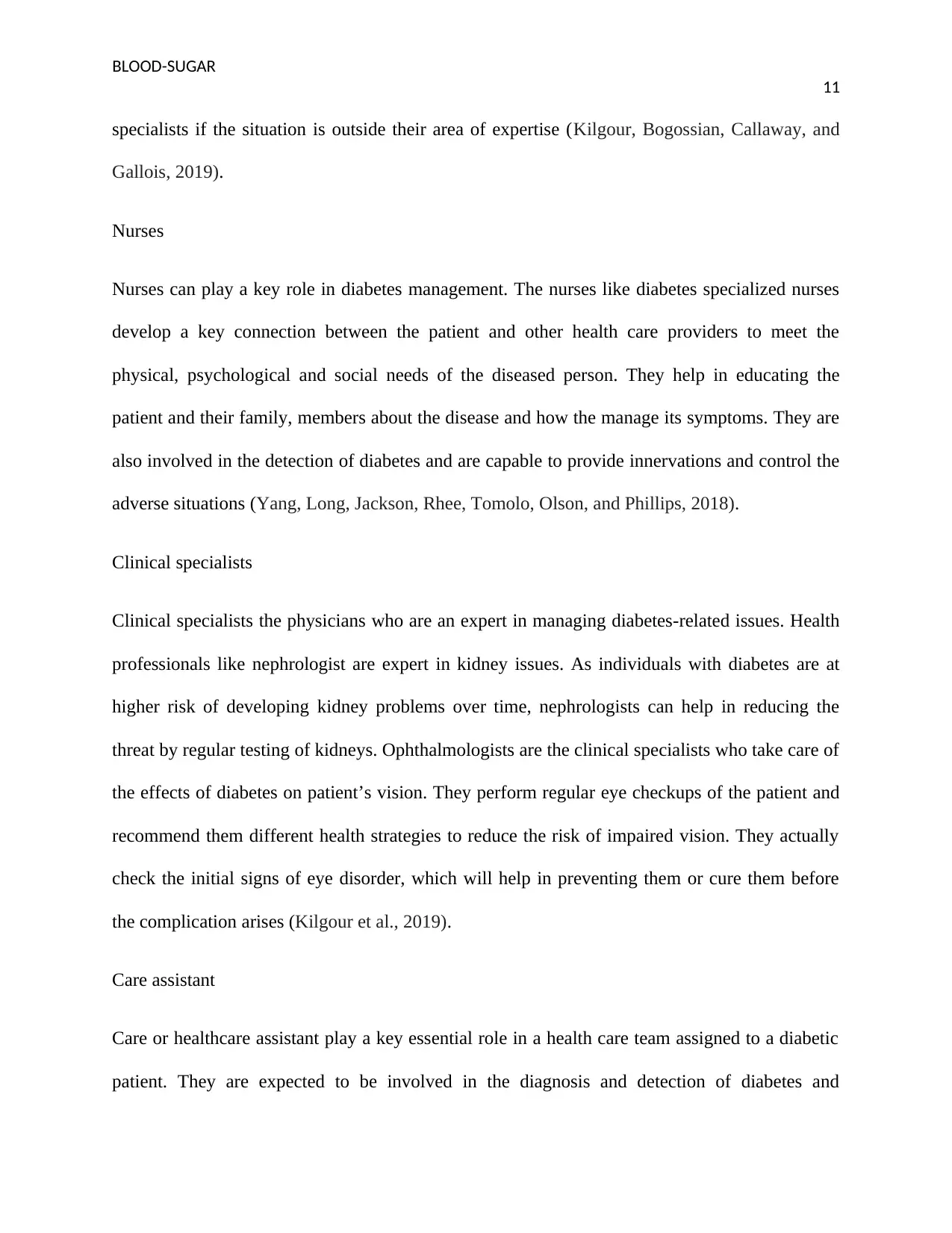
BLOOD-SUGAR
11
specialists if the situation is outside their area of expertise (Kilgour, Bogossian, Callaway, and
Gallois, 2019).
Nurses
Nurses can play a key role in diabetes management. The nurses like diabetes specialized nurses
develop a key connection between the patient and other health care providers to meet the
physical, psychological and social needs of the diseased person. They help in educating the
patient and their family, members about the disease and how the manage its symptoms. They are
also involved in the detection of diabetes and are capable to provide innervations and control the
adverse situations (Yang, Long, Jackson, Rhee, Tomolo, Olson, and Phillips, 2018).
Clinical specialists
Clinical specialists the physicians who are an expert in managing diabetes-related issues. Health
professionals like nephrologist are expert in kidney issues. As individuals with diabetes are at
higher risk of developing kidney problems over time, nephrologists can help in reducing the
threat by regular testing of kidneys. Ophthalmologists are the clinical specialists who take care of
the effects of diabetes on patient’s vision. They perform regular eye checkups of the patient and
recommend them different health strategies to reduce the risk of impaired vision. They actually
check the initial signs of eye disorder, which will help in preventing them or cure them before
the complication arises (Kilgour et al., 2019).
Care assistant
Care or healthcare assistant play a key essential role in a health care team assigned to a diabetic
patient. They are expected to be involved in the diagnosis and detection of diabetes and
11
specialists if the situation is outside their area of expertise (Kilgour, Bogossian, Callaway, and
Gallois, 2019).
Nurses
Nurses can play a key role in diabetes management. The nurses like diabetes specialized nurses
develop a key connection between the patient and other health care providers to meet the
physical, psychological and social needs of the diseased person. They help in educating the
patient and their family, members about the disease and how the manage its symptoms. They are
also involved in the detection of diabetes and are capable to provide innervations and control the
adverse situations (Yang, Long, Jackson, Rhee, Tomolo, Olson, and Phillips, 2018).
Clinical specialists
Clinical specialists the physicians who are an expert in managing diabetes-related issues. Health
professionals like nephrologist are expert in kidney issues. As individuals with diabetes are at
higher risk of developing kidney problems over time, nephrologists can help in reducing the
threat by regular testing of kidneys. Ophthalmologists are the clinical specialists who take care of
the effects of diabetes on patient’s vision. They perform regular eye checkups of the patient and
recommend them different health strategies to reduce the risk of impaired vision. They actually
check the initial signs of eye disorder, which will help in preventing them or cure them before
the complication arises (Kilgour et al., 2019).
Care assistant
Care or healthcare assistant play a key essential role in a health care team assigned to a diabetic
patient. They are expected to be involved in the diagnosis and detection of diabetes and
⊘ This is a preview!⊘
Do you want full access?
Subscribe today to unlock all pages.

Trusted by 1+ million students worldwide
1 out of 22
Related Documents
Your All-in-One AI-Powered Toolkit for Academic Success.
+13062052269
info@desklib.com
Available 24*7 on WhatsApp / Email
![[object Object]](/_next/static/media/star-bottom.7253800d.svg)
Unlock your academic potential
Copyright © 2020–2025 A2Z Services. All Rights Reserved. Developed and managed by ZUCOL.





